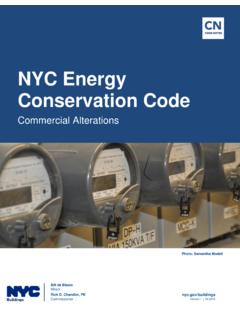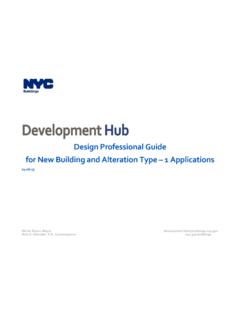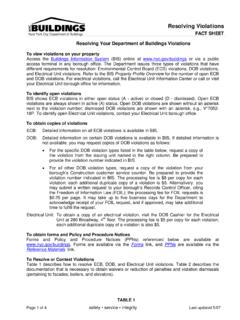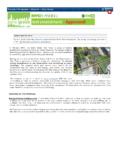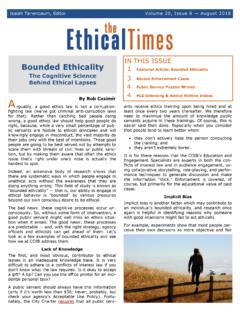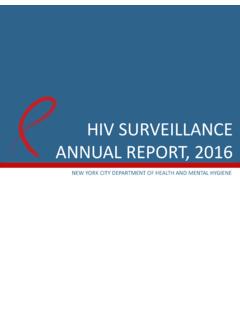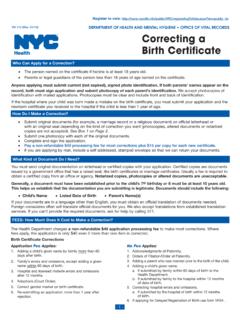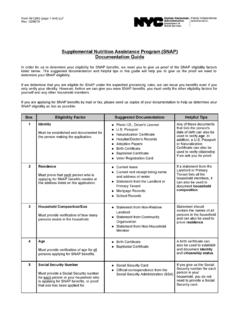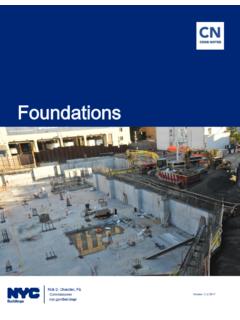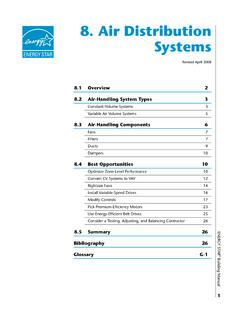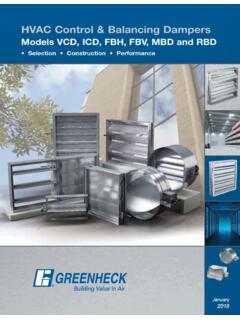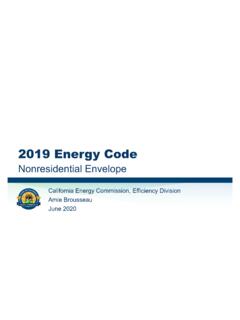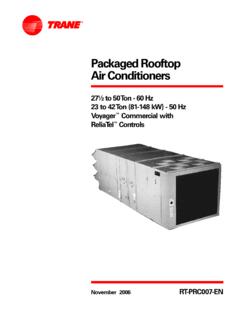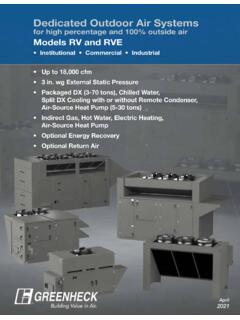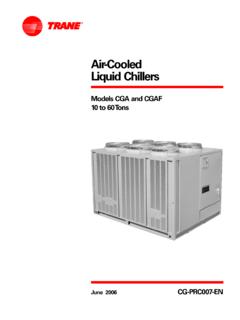Transcription of 2020 NYCECC - How-to Guide: Supporting Documentation ...
1 How-to Guide: Supporting Documentation In Compliance with 2020 New York City Energy Conservation Code GENERAL building ENVELOPE MECHANICAL SYSTEMS LIGHTING & ELECTRICAL POWER OTHER REQUIREMENTS NOTE: In this How-to Guide: Supporting Documentation , selected Energy Code provisions have been generalized, summarized, rephrased, and/or highlighted. This guide is intended: 1) To provide general guidance for the job applications seeking compliance with the 2020 NYCECC ; 2) Not to replace or represent the entire 2020 NYCECC and related regulations of the City of New York and the Department of Buildings; and 3) Not to provide complete compliance solutions for any particular type of job or work. Comprehensive mandates, applicability, exemptions, exceptions and options will be found in the 2020 NYCECC and related regulations of the City of New York and the Department of Buildings. GENERAL building ENVELOPE [BE - 1] MECHANICAL SYSTEMS LIGHTING & ELECTRICAL POWER OTHER REQUIREMENTS OPAQUE ENVELOPE ASSEMBLIES Minimum R-value - For each building envelope type ( , roof, above-grade/below-grade walls, floors over unconditioned space, etc.
2 , its section detail must indicate that the R-value of the insulation meets or exceeds the minimum allowed R-value prescribed for the envelope type ( , R-values shown in Table ). - Specifically, in the assembly details, clearly call out each of the proposed insulation type, thickness and the manufacturer-published R-value to satisfy the thermal requirements for the envelope assembly type. Maximum U-factor - Alternatively, it must be demonstrated that the proposed assembly s calculated U-factor (or C- or F-factor) value does not exceed the maximum allowed U-factor value prescribed for the envelope type ( , U-factors shown in Table ). - Determination of an assembly s overall U-factor (or C- or F-factor) value must be supported by the pre-calculated values or the calculation methods established in Appendix A of ASHRAE - Spandrel Panels are Opaque walls. Determination of effective U-factors for the proposed Spandrel Panels must follow Table Table See page [BE-9].
3 The proposed U-factor value identified from the Table must be compared against the baseline U-factor of metal-framed walls ( ) in COMcheck. Figure BE-1. Sample Wall Assembly & Area-Weighted U-factor Calculation NOTE: One common error in the U-factor calculation is misrepresenting thermal values of assembly layers ( , face brick, gypsum board, air films, etc.) from unapproved sources. GENERAL building ENVELOPE [BE - 2] MECHANICAL SYSTEMS LIGHTING & ELECTRICAL POWER OTHER REQUIREMENTS Figure BE-2. Sample Window & Door Schedule WINDOWS & DOORS FENESTRATION IN THE ENVELOPE U-factor and SHGC values - For each fenestration type ( , fixed/operable window, skylight, exterior door, storefront, etc.), Assembly U-factor and Solar Heat Gain Coefficient (SHGC) values must be specified in the window/door schedule on drawings, and must not exceed the maximum allowed values.
4 For commercial building windows, the maximum assembly U-factors depend on the vertical location of the window on the above-grade wall, with more stringent U-factors for windows installed below 95 above-grade. See page [BE-3]. The 95 demarcation line must be indicated on building elevation drawings for commercial buildings. - Next to the U-factor and SHGC values specified in the schedule, provide the fenestration assembly manufacturer s information ( , ABC Windows/xyz 9000 series, or Approved equal ) that will satisfy the U-factor and SHGC requirements. 1 RCNY 5000-01 (g)(1)(i) air leakage Rate and Visible Transmittance (VT) - The window/door schedule on drawings must specify the air leakage rate of each proposed fenestration assembly type to demonstrate that the air leakage of fenestration assemblies do not exceed the maximum allowed leakage rate. - Where required, the window/door schedule must identify Visible Transmittance (VT) of the proposed glazed fenestration products to meet the provisions in the applicable Code sections.
5 WINDOW & DOOR SCHEDULE TAG TYPE FRAJE MATERIAL NOMINAL DIM. (W X H) MANUFACTURER - MODEL NO. ASSEMBLY U-FACTOR SHGC VT air leakage RATE (CFM/SF) W1 FIXED METAL 7'-0" X 7'-0" ABC WINDOWS - D999 SERIES OR APPROVED EQUAL W2 CASEMENT - OPERABLE METAL 4'-6" X 2'-3" ABC WINDOWS -EF00 SERIES OR APPROVED EQUAL SW1 SKYLIGHT METAL 2'-10" X 5'-2" SKL CORP. - GHT000 SERIES OR APPROVED EQUAL W5 STOREFRONT - FIXED GLAZING METAL VARIES; SEE A-301 ~305 FOR LOCATIONS & DIM. GLD CO. - STR #Z111 OR APPROVED EQUAL D1 STOREFRONT - ENTRANCE GLASS DOOR METAL 3'-0" X 7'-6" GLD CO. - STR #Z111 OR APPROVED EQUAL D2 OPAQUE SWINGING DOOR METAL 3'-0" X 7'-0" OPQ COMPANY RST-#22-33 OR APPROVED EQUAL N/A N/A Fenestration U-factor values must be the whole assembly U-factor, instead of center-of-glass U-factor, and must be furnished by the manufacturer. Differentiate Fixed and Operable windows U-factor values in the window schedule where required, as the Code-prescribed maximum U-factors for Fixed and Operable windows may vary depending on the referenced Code.
6 GENERAL building ENVELOPE [BE - 3] MECHANICAL SYSTEMS LIGHTING & ELECTRICAL POWER OTHER REQUIREMENTS SPANDREL PANEL EFFECTIVE U-FACTORS commercial building FENESTRATION MAXIMUM U-FACTORS See Table for ASHRAE-following job applications. NOTE 1: To demonstrate compliance, provide COMcheck envelope analysis by: - entering the Proposed Spandrel panel U-factor value identified from the Table ; and - choosing the Baseline U-factor of metal-framed walls ( ). NOTE 2: If the Proposed Spandrel panel type is not found in the Table , Assembly with backpans, Assembly with no insulation THERM Analysis must be performed and documented on drawings. Info for THERM is found in the link below. NOTE: Where any portion of the window unit is installed above 95 above-grade, U-factor requirement of 95 and above may apply. GENERAL building ENVELOPE [BE - 4] MECHANICAL SYSTEMS LIGHTING & ELECTRICAL POWER OTHER REQUIREMENTS Figure BE-4.
7 Examples of Balcony and Parapet Insulation CONTINUOUS INSULATION Balconies and Parapets Balconies and Parapets that interrupt the building thermal envelope are required to be: a) Insulated with continuous insulation of a minimum R-value for the wall assembly as listed in Table Table OR b) Insulated with a minimum R-3 thermal break where the structural element penetrates the building thermal envelope. To report R-value of Parapet as a Roof component in COMcheck Envelope Analysis, click Here. To report R-value of Balcony slab as a Wall component in COMcheck Envelope Analysis, refer to [BE- 11]. a) COMPLIANT with b) NOT COMPLIANT with NOTE: Compliance with the continuous insulation requirements on balconies and parapets does not relieve compliance requirements of other applicable Construction Codes. For example, BC Chapter 16 and Chapter 33 requirements must be met for parapets in case of future C-hooks/ clamps use on the parapet walls.
8 GENERAL building ENVELOPE [BE - 5] MECHANICAL SYSTEMS LIGHTING & ELECTRICAL POWER OTHER REQUIREMENTS FENESTRATION AREA The Window-to-Wall Ratio (WWR) -- the ratio (%) of vertical fenestration area to gross above-grade wall area (or gross wall area for Appendix CA applications) -- must be noted on an EN- labeled drawing in conjunction with building envelope diagrams and the envelope energy analysis. The building envelope diagrams must list all opaque wall areas and vertical fenestration areas per each building orientation. The area values of each opaque wall type and fenestration type listed in the envelope diagrams must match the values entered in the envelope energy analysis ( , Gross Area values in COMcheck). Maximum Vertical Fenestration Area (when following ECC) - Maximum WWR: 30% - Maximum WWR: 40% permitted with certain requirements including daylight responsive controls - When WWR > 40%: ASHRAE must be chosen as Code Compliance Path, as ECC does not allow WWR > 40%.
9 Maximum Vertical Fenestration Area (when following ASHRAE) - Maximum WWR: 40% - When WWR > 40%: Energy Code compliance may be demonstrated through either a) COMcheck (with envelope tradeoff) envelope analysis, or b) Energy Modeling (total building performance) energy analysis. Maximum Skylight Fenestration Area - Maximum skylight fenestration area: 3% of the gross roof area - Maximum skylight fenestration area: 6% of the gross roof area permitted with daylight responsive controls Minimum Skylight Fenestration Area - For an enclosed space 2,500 sf, and directly under a roof with ceiling height > 15 and of space types including office, lobby, atrium, concourse, corridor, warehouse storage, among others Minimum skylight fenestration area requirement: Minimum 3% of the gross roof area, or Minimum 1% Skylight Effective Aperture - See Section and for complete applicable space types, minimum total daylight area requirement, and definition of Skylight Effective Aperture.
10 GENERAL building ENVELOPE [BE - 6] MECHANICAL SYSTEMS LIGHTING & ELECTRICAL POWER OTHER REQUIREMENTS AIR BARRIER Continuous Air Barrier To ensure air barrier continuity in the building thermal envelope, drawings must specify required continuous air barrier construction measures (Section ), and indicate that the continuous air barrier shall be achieved by either 1) Materials not exceeding maximum allowed air permeability (Section ), or 2) Assemblies not exceeding allowed maximum air leakage (Section ). Openings in the building Envelope Drawings must identify specific construction measures, configuration, devices and/or performance standards to limit air leakage in particular envelope areas including, but not limited to, the following: 1) Fenestration and doors: Maximum allowed air leakage . 2) Outdoor air intakes and exhaust openings: Motorized Shutoff dampers are required unless gravity dampers are allowed. 3) Doors/Access Openings to shafts, chutes, vents, stairways and elevator lobbies: Gasketing, weatherstripping, and sealing.
